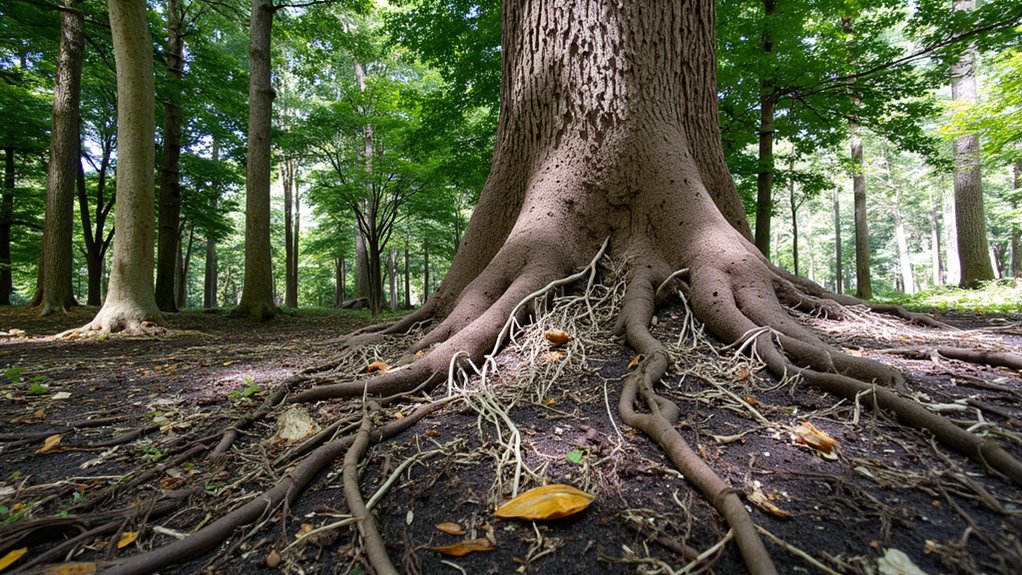You’ve probably walked through a forest without realizing you’re stepping over nature’s internet. Beneath your feet lies an intricate network of fungal threads connecting trees in ways that seem almost impossible. These underground highways carry messages and resources between trees up to 40 meters apart, allowing them to share nutrients and warn each other about threats. What’s even more fascinating is how these forest communities organize themselves through this hidden web.
Contents
Understanding the Wood Wide Web

While scientists once believed trees were solitary organisms, we now know they’re connected through an intricate underground network nicknamed the “Wood Wide Web.” This complex system consists of fungal threads called mycorrhizal networks that link tree roots together, allowing them to share nutrients, water, and information.
You’ll find these fungal networks extending up to 30 feet from each tree, creating vast interconnected webs throughout the forest. When you examine them closely, you’ll see how the fungi form tiny thread-like structures called hyphae that penetrate tree roots at a microscopic level.
These connections enable trees to send chemical and electrical signals to warn neighboring trees about threats like insect invasions or drought conditions.
The Role of Mycorrhizal Fungi Networks

Although mycorrhizal fungi networks might look like simple threads to the naked eye, they’re actually sophisticated biological highways that form mutually beneficial partnerships with trees. These fungal networks can extend up to 30 feet from a single tree, connecting hundreds of plants in the process.
You’ll find these networks operating like nature’s internet, transferring nutrients, water, and chemical signals between trees. When you examine a teaspoon of healthy soil, you’re looking at several miles of fungal threads that create complex underground connections.
The fungi receive sugars from the trees while helping their hosts share resources, effectively turning forests into interconnected superorganisms.
Chemical Signals and Nature’s Language

Trees speak a sophisticated chemical language that you can’t hear but that shapes entire forest ecosystems. When a tree is under attack from insects or disease, it releases specific volatile organic compounds (VOCs) into the air, warning its neighbors of the threat.
You’ll find these airborne messages triggering nearby trees to boost their natural defenses, producing extra tannins and other protective chemicals. The process typically takes 15-20 minutes, giving surrounding trees time to prepare their defenses before the threat reaches them.
Trees also release stress hormones like ethylene, which can travel up to 100 feet through the air, creating a complex web of chemical communication.
Mother Trees and Their Offspring
Deep within forest networks, mature “mother trees” serve as essential hubs that nurture and protect younger seedlings. You’ll find these elder trees sharing nutrients, water, and carbon with nearby saplings through underground fungal networks, which scientists call mycorrhizal connections.
When you examine a mother tree’s behavior, you’ll notice it recognizes and preferentially supports its own offspring. These trees can transfer up to 40% of their carbon to younger trees, ensuring their survival during times of stress. They’ll even reduce their own root competition to give their seedlings a better chance at establishing themselves in the forest community.
Underground Resource Sharing
Beneath every thriving forest lies an intricate network of fungal connections that you’d find fascinating. Known as mycorrhizal networks, these underground highways transport water, carbon, nitrogen, and other nutrients between trees through microscopic fungal threads.
You’ll see how a single tree can connect to dozens of others through this web, sharing resources in times of need. When you examine these connections closely, you’ll discover that larger trees typically send more carbon to smaller ones, while dying trees will often transfer their remaining resources to their neighbors through these fungal pathways.
Survival Strategies and Warning Systems
Beyond sharing nutrients, these underground networks serve as sophisticated warning systems for forest communities. When you examine how trees communicate danger, you’ll find they release chemical signals through their roots and fungal networks to warn nearby trees of threats.
If a tree’s being attacked by insects, it’ll send out specific compounds that prompt neighboring trees to start producing protective chemicals. You can actually measure these defensive responses within hours of the initial alert. The warning signals travel up to 30 meters through the underground network, giving the forest community time to mount defenses against incoming threats.
The Impact of Forest Communities
Through their interconnected networks, forest communities create impacts that extend far beyond individual trees. You’ll find that when trees share resources through mycorrhizal networks, they’re supporting not just their offspring but also their neighbors, creating a more resilient ecosystem.
You can observe this impact when you look at forest recovery after disturbances. When older trees detect threats, they’ll send chemical signals through their roots, warning younger trees within a 30-meter radius to prepare their defenses. This cooperative system means that connected forests are 4-5 times more likely to survive environmental stresses than isolated stands.
Protecting Nature’s Communication Network
Modern forest conservation must account for these remarkable underground networks that sustain woodland communities. You’ll need to protect both mature “mother trees” and their fungal connections, as they’re essential hubs in the forest’s communication web.
When you’re managing forests, it’s vital to leave at least 20-30% of the old trees standing, spaced no more than 20 meters apart. This maintains the mycelial network’s integrity. You should also avoid using broad-spectrum fungicides within 50 meters of established tree stands, as these chemicals can disrupt the delicate mycorrhizal partnerships that have taken decades to develop.
